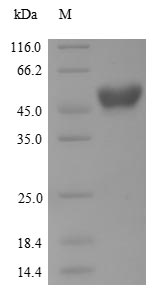Amino acids 1-207 constitute the expression domain of recombinant Human AANAT. This AANAT protein is theoretically predicted to have a molecular weight of 51.8 kDa. This AANAT protein is produced using e.coli expression system. Fusion of the N-terminal 10xHis-GST tag into the AANAT encoding gene fragment was conducted, allowing for easier detection and purification of the AANAT protein in subsequent stages.
Human serotonin N-Acetyltransferase (AANAT) is a key enzyme in the synthesis of melatonin, the hormone that regulates circadian rhythms. AANAT catalyzes the conversion of serotonin to N-acetylserotonin, a precursor in melatonin biosynthesis. In chronobiology, AANAT is pivotal for the molecular clock, linking light-dark cycles to melatonin production. In neuroscience, AANAT influences sleep-wake cycles and mood regulation. In endocrinology, melatonin has roles in reproductive physiology and immune function. Investigating AANAT provides insights into circadian rhythm regulation, sleep disorders, and mood-related conditions, offering potential applications in chronotherapy, neuropsychiatry, and endocrine research for therapeutic interventions and understanding melatonin's broader physiological roles.






